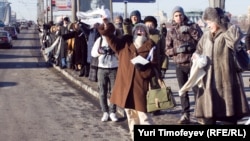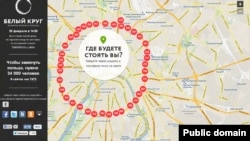Russia's new protest movement proved itself tech-savvy and digitally enabled early on, with massive protests against December's disputed parliamentary elections organized largely through social media.
The vote also produced an outpouring of online violations reports, many submitted by smartphones and some backed by video evidence, collected onto the website kartanarusheniy.org. Maintained by Golos, a Western-financed election-monitoring group, the online "Map of Violations" uses a mapping platform to organize reported violations geographically. The site is already collecting reports of violations ahead of the presidential election on March 4.
The planning for a protest on February 26, however, appears to be a sign of the protest movement's increasing resourcefulness in tailoring internet-based technology to its needs.
Participants in the "Big White Circle" flash mob intend to create a human chain around the center of Moscow, massing along the city's 16-kilometer Garden Ring road to "encircle the Kremlin." The protest is apparently a follow-up to demonstrations last month, when thousands of cars flying white ribbons and balloons clogged the same road.
To organize the protest, the "For Fair Elections" group created the feb26.ru website, which makes an innovative pairing of social media and online mapping tools.
After logging in to Facebook, Twitter, or the Russian social media sites VKontakte and Odnoklassniki, participants "check in" and reserve various spots on the ring, while also seeing who else has registered to be at the spot.
Gregory Asmolov, an expert on trends in the Russian internet and the co-founder of Help Map, a crowdsourcing platform used to coordinate assistance to victims of Russia's deadly 2010 wildfires, says the website represents a step up in the protest movement's use of Internet technology.
"The capacity of people to develop a specific tool very fast -- just in a few days -- to organize a very specific type of event, I think is very interesting," Asmolov says. "It shows more skills and [internet] literacy in general and more potential for usage of technologies to address specific challenges -- in this particular context the challenge being how to organize a huge crowd that should stand in a very particular arrangement."
Organizers of the "Big White Circle" say they need 34,000 people to complete the human ring. Some 7,500 people had indicated their participation by late on February 24.
According to Sergei Udaltsov, an organizer of the opposition protests and the head of the Left Front movement, the circle protest was planned after Moscow authorities rejected a petition for a traditional rally.
"The Moscow Times" reports that feb26.ru experienced a denial-of-service attack on February 20, a technique often used by hackers to disable websites.
Experts say the website will not be the last example of tailored use of Internet technology for the purposes of the protest movement.
"Web Observer," a mobile-phone application slated for release ahead of the March 4 presidential vote, will streamline the process of filing an electoral violation report with Golos's online database.
The vote also produced an outpouring of online violations reports, many submitted by smartphones and some backed by video evidence, collected onto the website kartanarusheniy.org. Maintained by Golos, a Western-financed election-monitoring group, the online "Map of Violations" uses a mapping platform to organize reported violations geographically. The site is already collecting reports of violations ahead of the presidential election on March 4.
The planning for a protest on February 26, however, appears to be a sign of the protest movement's increasing resourcefulness in tailoring internet-based technology to its needs.
Participants in the "Big White Circle" flash mob intend to create a human chain around the center of Moscow, massing along the city's 16-kilometer Garden Ring road to "encircle the Kremlin." The protest is apparently a follow-up to demonstrations last month, when thousands of cars flying white ribbons and balloons clogged the same road.
To organize the protest, the "For Fair Elections" group created the feb26.ru website, which makes an innovative pairing of social media and online mapping tools.
After logging in to Facebook, Twitter, or the Russian social media sites VKontakte and Odnoklassniki, participants "check in" and reserve various spots on the ring, while also seeing who else has registered to be at the spot.
Gregory Asmolov, an expert on trends in the Russian internet and the co-founder of Help Map, a crowdsourcing platform used to coordinate assistance to victims of Russia's deadly 2010 wildfires, says the website represents a step up in the protest movement's use of Internet technology.
"The capacity of people to develop a specific tool very fast -- just in a few days -- to organize a very specific type of event, I think is very interesting," Asmolov says. "It shows more skills and [internet] literacy in general and more potential for usage of technologies to address specific challenges -- in this particular context the challenge being how to organize a huge crowd that should stand in a very particular arrangement."
Organizers of the "Big White Circle" say they need 34,000 people to complete the human ring. Some 7,500 people had indicated their participation by late on February 24.
According to Sergei Udaltsov, an organizer of the opposition protests and the head of the Left Front movement, the circle protest was planned after Moscow authorities rejected a petition for a traditional rally.
"The Moscow Times" reports that feb26.ru experienced a denial-of-service attack on February 20, a technique often used by hackers to disable websites.
Experts say the website will not be the last example of tailored use of Internet technology for the purposes of the protest movement.
"Web Observer," a mobile-phone application slated for release ahead of the March 4 presidential vote, will streamline the process of filing an electoral violation report with Golos's online database.



















